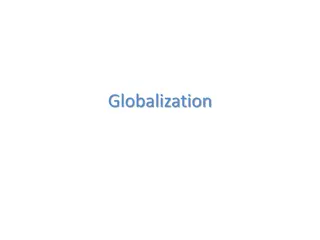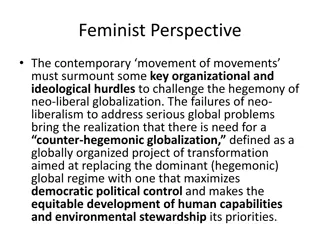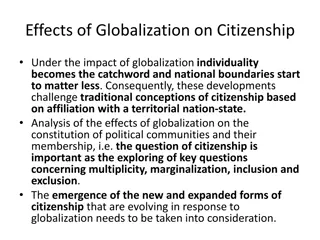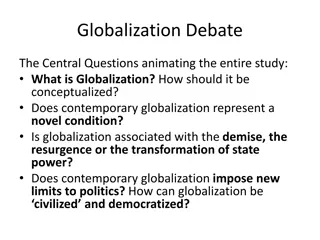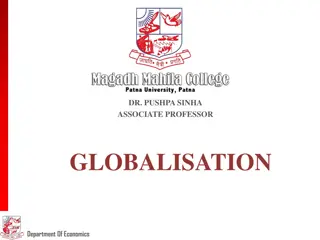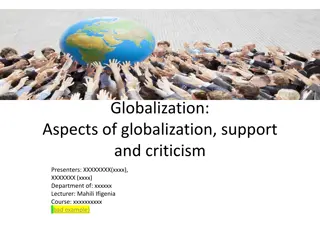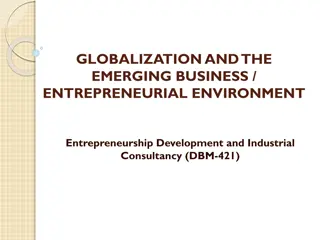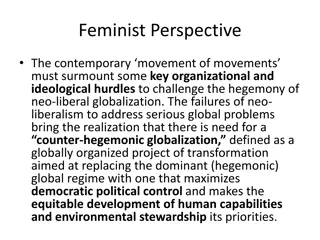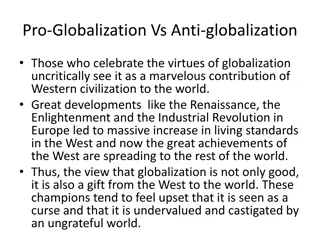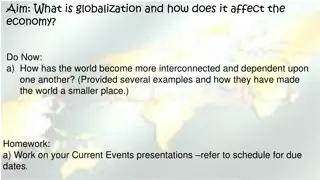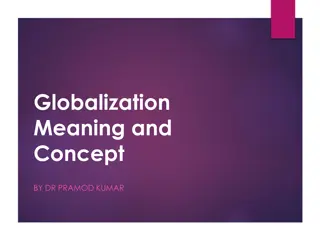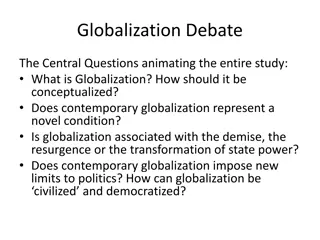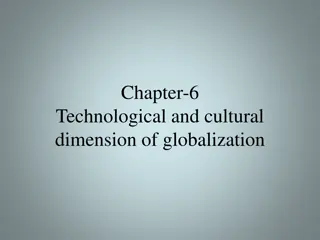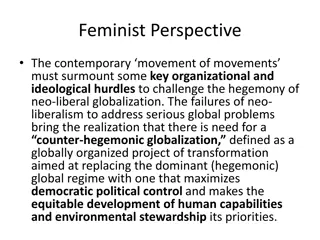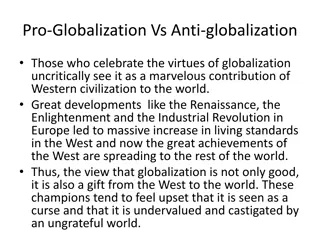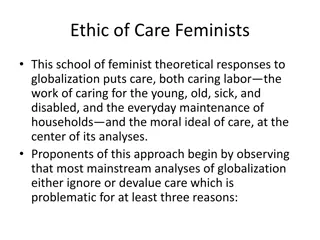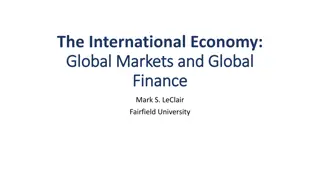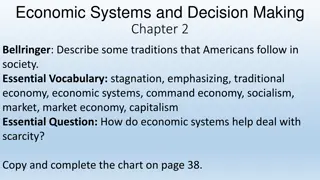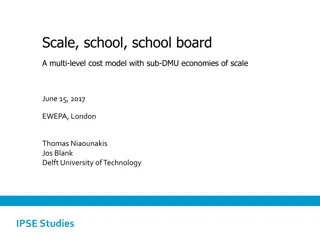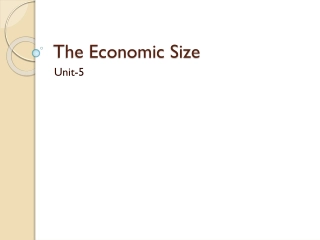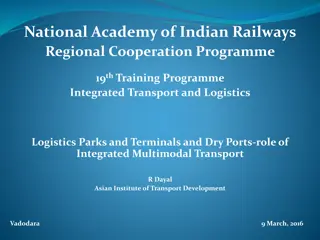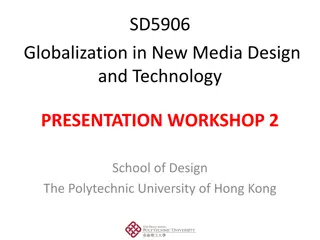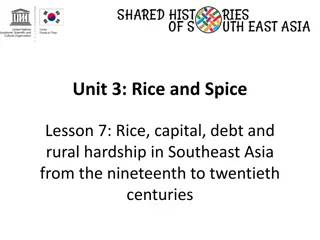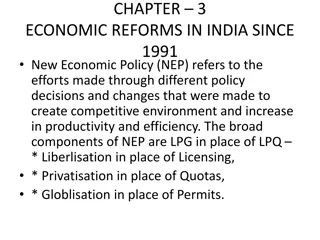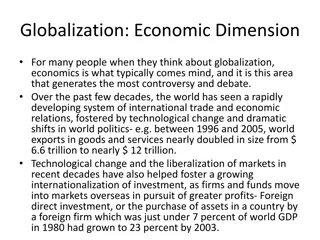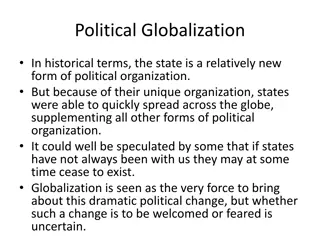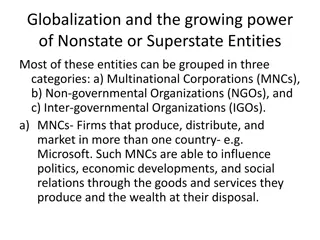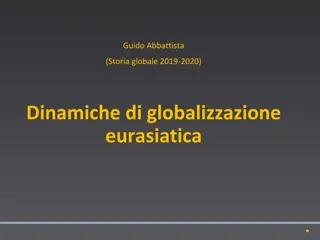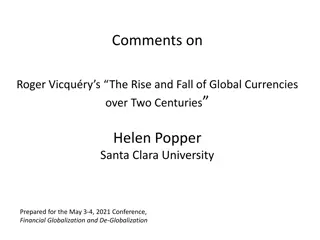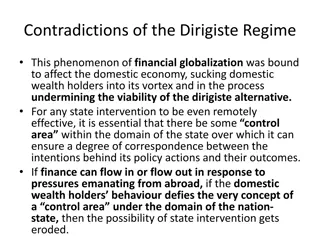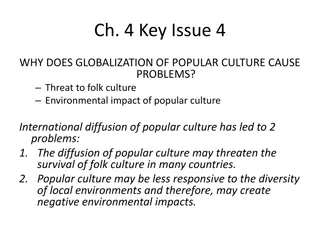Understanding Globalization and Integrated Economies
Globalization has led to economic integration among countries, breaking down trade barriers and fostering social, political, and cultural connections. This integration has both positive and negative impacts, with advancements in technology and communication enabling businesses to expand globally. However, it also drives firms to seek lower labor costs in developing countries. The level of integration in a target country is influenced by social, economic, and political factors, ultimately affecting its global competitiveness.
Download Presentation

Please find below an Image/Link to download the presentation.
The content on the website is provided AS IS for your information and personal use only. It may not be sold, licensed, or shared on other websites without obtaining consent from the author. Download presentation by click this link. If you encounter any issues during the download, it is possible that the publisher has removed the file from their server.
E N D
Presentation Transcript
GOING GLOBAL GOING GLOBAL
Globalization Simply means that the world has become integrated economically- look for countries that eliminated trade barriers socially, politically, and culturally, through the advances of: technology, transportation, and communication Globalization has brought about both positive and negative effects On the positive side: advances in science & technology have allowed businesses to easily cross over territorial lines as a result, firms tend to be more productive and competitive thereby raising quality of goods, services and the world s living standards Negatively for developed countries firms establish foreign operations to take advantage of low labor costs in poorer countries
Driver to pick a location how integrated is target country/society. Social, econimic and political integrity
Worlds Most Integrated Countries Based on 4 factors: Economic Integration the elimination of trade barriers and import quotas preferential trade agreements, free trade areas, etc. e.g. NAFTA in periods of economic growth, being integrated is great in poor growth periods, integration worsens the situation as individual governments have less control over their economies Social Contact removal of barriers to education elimination of gender discrimination reducing poverty which blocks access to healthcare, housing, social services & employment other barriers that must be removed include low levels of social protection, disparity of wealth, stigma, poor governance and lack of opportunities to participate in policy making Political Engagement the ability of nations to promote negotiated settlements to conflicts, to provide foreign aid, to respect treaties and foreign organizations & to engage in peacekeeping activities Cultural Integration movement of minority groups into the mainstream societies requires proficiency in a common language, acceptance of laws and adoption of a common set of values when members are being transparent in all of their various work, personal, faith and local community interactions without any members giving up their culture Singapore & Hong Kong are the world s most integrated countries; the USA and Canada are 7th& 8th
Global Economic Integration File:Economic integration stages (World).png Stages of economic integration around the World: (each country colored according to the most advanced agreement in which it participates. Economic and Monetary Union (ICSME/EC$, EU/ ) Economic Union (CSME, EU) Customs and Monetary Union (CEMAC/franc, UEMOA/franc) Common Market (EEA, EFTA, CES) Customs Union (CAN, CUBKR, EAC, EUCU, MERCOSUR, SACU) Multilateral Free Trade Area (AFTA, CEFTA, CISFTA, COMESA, GAFTA, GCC, NAFTA, SAFTA, SICA, TPP)
Major Regional Trading Blocs EU ( EU (European Union) 27 nations 400 million people free movement of goods & people among EU countries Fortress Europe a market giving preference to insiders ASEAN ASEAN (Association of Southeast Asian Nations) 13 countries manufacturing accounts for 30% of the GDP of Asia s emerging markets Australia & New Zealand have signed a friendship treaty with Southeast Asia SAARC SAARC (South Asia Association of Regional Cooperation) ) 7 countries Bangladesh, Bhutan, India, the Maldives, Nepal, Pakistan & Sri Lanka 1.5 billion people NAFTA NAFTA (North American Free Trade Agreement) between Canada, the U.S.A. and Mexico 421 million consumers DR DR- -CAFTA CAFTA (Dominion Republic & Central America Free Trade Agreement) between the U.S.A and Costa Rica, El Salvador, Guatemala, Honduras, Nicaragua & Dominican Republic MERCOSUR MERCOSUR (Mercado Com n del Sur/ Common Market of the South) between Brazil, Argentina, Paraguay & Uruguay (Venezuela has made application) 4thlargest trading bloc with 250 million people and representing 75% of South America s GDP OTHER OTHER The Russian Federation, United Arab Emirates, the African Union
Proactive Reasons for Going Global Economies of Scale firms want to achieve world-scale volume in order to: make the fullest use of modern capital-intensive manufacturing equipment amortize staggering R&D costs when facing brief product life cycles (e.g. pharma industry) Growth Opportunities companies in mature markets in developed countries look for new opportunities in emerging markets Resource Access & Cost Savings resource availability offers both greater control over inputs & lower transportation costs Customer Demands foreign operations often start as a response to customer demands or as a solution to logistical problems certain foreign customers may insist that their supplier operate in their local region Responding to Incentives governments seeking new capital infusions, technology advancements & manufacturing know-how willingly provide incentives tax exemptions tax holidays subsidies loans and use of property these incentives not only decrease risk but also increase profits
Reactive Reasons for Going Global Globalization of Competitors competitors who already have overseas operations may capture so much market share, that it is impossible to penetrate later lower costs & market power may give them an advantage domestically strategic moves by global giants prompt countermoves or copy-cat strategies by other firms in the industry Trade Barriers restrictive trade barriers imposed by some governments prompt a switch from exporting to overseas manufacturing these barriers include: tariffs quotas buy-local policies Regulations & Restrictions policies imposed by a firm s home government may become so expensive that firms seek out less restrictive foreign operating environments Customer Demands foreign operations often start as a response to customer demands or as a solution to logistical problems certain foreign customers may insist that their supplier operate in their local region Cost Savings lower labor and manufacturing costs lowers unit costs and permits firms to better compete in mature markets
Approaches to World Markets Global Strategy Global Strategy treat the world as an undifferentiated worldwide marketplace establish worldwide operations develop standardized products & marketing the competitive rationale is to establish: worldwide economies of scale offshore manufacturing and international cash flows one of the quickest & cheapest ways to develop a global strategy is through strategic alliances global organizations are difficult to manage because doing so requires the coordination of broadly divergent national cultures means that firms must lose some of their original identity problems with this approach lack of local flexibility & responsiveness neglect of the need for differentiated products or services Cont d.
Approaches to World Markets Regionalization Regionalization in industries in which competitiveness is determined on a country-by-country basis rather than on a global basis, a regional strategy is more appropriate local markets are linked together within a region allows for more local responsiveness & specialization top managers within each region decide on their own: investment locations product mixes and competitive positioning they run their subsidiaries as quasi-independent organization There should be some rationale to the formation of regions Ghemawat proposed the CAGE framework Cultural distance form regions around countries that have similar cultural backgrounds Administrative distance choose countries that have similar forms of government, legal systems & rules Geographic distance whenever possible expand like an inkblot to the countries close in distance Economic distance choose countries that have reached a similar level of development Cont d.
Approaches to World Markets contd. Localization Localization localization pressures include: unique consumer preferences resulting from cultural or national differences domestic subsidies new production technologies that facilitate product variation for less cost Global Integrative Strategies Global Integrative Strategies many multinationals develop their global operations to the point of being fully integrated often both vertically & horizontally includes facilities around the world like: suppliers productive facilities marketing distribution outlets and contractors Cont d.
Approaches to World Markets contd. Normal Progression Normal Progression Starts with simple exporting Licensing or Franchising Moving part of an operation to another country Contracting a foreign agent to operate an operation in a host country Signing a srategic alliance agreement with a foreign organization Forming a joint venture with a foreign partner Buying a foreign company or merfing with one Establishing a fully-owned subsidiary More Recently Companies are BORN GLOBAL More Recently Companies are BORN GLOBAL brought about by the internet that allows small firms to attain global reach also through the hiring of people with international experience & contacts have issues assessing resources & physical & cultural distances of markets Cont d.
International Growth Strategies growth strategies are centered on ways to gain market share either by attracting it away from the competition or by entering virgin markets first with new & improved products/services these alternatives are not mutually exclusive; several can be employed at the same time they are presented in the normal order as the list advances , more risk will likely be faced Exporting Exporting testing the overseas market low risk little investment is involved fast withdrawal is relatively easy typically done by: appointing a manager to handle these sales establishing an export department retaining an export management company choice of distributor is most important other critical environmental factors export/import quotas freight costs distance from supplier countries Cont d.
International Growth Strategies e e- -Commerce Commerce companies of all sizes are increasingly using the internet to expand global operations it is probably the fastest way to become a global player the following variables are important rate of internet penetration level of development of the local telecommunications infrastructure Licensing Licensing gives a host country firm the right to sell and/or produce a foreign company s product agreement involves a limited period transfer of rights to: patents trademarks or technology for a the licensee pays a fee for this right advantages: it is a relatively low risk strategy because it involves little investment a useful option in countries where market entry by other means is difficult ideal approach in countries where profit repatriation is restricted it avoids tariffs and quotas sometimes imposed on exports worst disadvantage: the lack of control over the licensee s practices & performance critical environmental factors to consider: sufficient patent & trademark protection the track record of the licensee the risk that the licensee may develop its competence & become a direct competitor how wide the licensee s market territory is legal limits on the royalty rate structure imposed by the host government Cont d.
International Growth Strategies contd. Franchising Franchising franchisor licenses its: trademark products or services and operating principles . to a franchisee for an initial fee & ongoing royalties usually no time limit is set advantages: involves relatively little risk involves relatively little investment in capital & human resources a critical consideration is quality control so that the brand is not damaged Off Off- -Shoring Shoring a firm moves one or all of its factories from the home country to another provides the company with access to foreign markets while avoiding trade barriers Management Contracts Management Contracts gives a foreign company the rights to manage the daily operations of a business the foreign company cannot make decisions regarding ownership, financing or strategic or policy changes Non Non- -Equity Strategic Alliances Equity Strategic Alliances agreements carried out through contracts rather than ownership often with a firm s suppliers, distributors or manufacturers - consortium sometimes two companies in the same industry agree to cooperate rather than compete e.g. airlines feed each other passengers by agreement Cont d.
International Growth Strategies contd. Joint Ventures Joint Ventures involves an agreement by two or more companies to produce a product or service together it facilitates rapid entry into new markets by means of an already established partner one who has local contacts & familiarities with local operations they can be a means to overcome trade barriers allow both partners to establish significant economies of scale & thus this has a huge positive impact on each partner s competitive position can be used to secure additional raw materials & managerial & technological skills it requires a higher level of capital investment & risk it is however a less risky method of operating in a foreign environment than going it alone it reduces the risks of expropriation & harassment by the host country in some cases, it may be the only way to enter certain countries partners must share management & decision making for a successful alliance when choosing a partner make certain that there will be enough of a fit between the: partners objectives strategies and resources . to make the venture work some pitfalls include: potential loss of technology, knowledge & skill base incompatibility over management & control systems conflicting goals & objectives cultural clashes Cont d.
International Growth Strategies contd. Joint Ventures Joint Ventures cont d. Motivation & Benefits of Global Alliances to avoid import barriers, licensing requirements & other protectionist legislation to share the costs & risks of the research & development of new products & processes to gain access to specific markets where regulations favor domestic companies to reduce political risk while making inroads into a new market to gain rapid entry into a new or consolidating industry & to take advantage of synergies Alliances between Multinationals & Local Small Enterprises to capture new ideas & innovations small local firms should seek opportunities to offer multinationals complementary technologies as well as local market networks a key to managing alliance portfolios is to consider not only what each partner will bring but also how each partner will affect other partners in the portfolio a long courtship with a potential partner usually results in a better alliance establishing compatible strategies & a coordinated set up plan setting up some pilot programs on a short-term basis can highlight problem areas Cont d.
International Growth Strategies contd. Joint Ventures Joint Ventures cont d. Alliances between Multinationals & Local Small Enterprises cont d. choose a partner with compatible strategic goals & objectives form an alliance that will result in synergies through: combined markets complimentary technologies and compatible management styles seek alliances where complimentary skills, products & markets will result if each partner brings distinctive skills & assets to the venture, each partner will need each other and competition is not likely to ensue begin the alliance in as balanced a relationship as possible it is usually easier to manage if one player plays the dominant role the dominant partner should have more decision-making responsibility over day-to-day operations where ownership is divided among several partners, daily operations are usually delegated to the local partner keeping partners out of daily operations increased autonomy tends to reduce staffing friction, blocked communication and blurred organizational culture special training to managers about the unique nature & issues with joint ventures can reduce issues of conflicting goals & different working practices of partners work out ahead of time how you will deal with proprietary technology or competitively sensitive information trust is essential to an alliance but should be backed up by contractual agreements recognize that most alliances last only a few years usually break up when one of the partners feels it can go it alone with an inevitable split in mind, it is to each partner s advantage to quickly & thoroughly learn all it can from the partner Cont d.
International Growth Strategies contd. Mergers & Acquisitions Mergers & Acquisitions where foreign-owned businesses are permitted foreign company acquires or merges with an existing firm in the host country allows for rapid entry into a market with established products & distribution networks provides a level of acceptability requires large capital investment Establishing a Fully Establishing a Fully- -Owned Subsidiary from Scratch Owned Subsidiary from Scratch must be permitted by the host government allows firms to get around import quotas the highest level of risk political instability can be devastating to a fully-owned foreign subsidiary negative local attitudes toward foreign ownership currency instability laws against profit repatriation the threat of expropriation & nationalism such a strategy however allows the firm to have full control over decision making & efficiency gives the firm the ability to integrate operations with overall company-wide strategy
International Defensive Strategies defensive strategies are used by companies to stop competitors from gaining any of their market share they accomplish this by either: patching holes in their offerings immediately matching moves of competitors keeping costs as low as possible Contract Manufacturing Contract Manufacturing using cheap labor overseas contracting for the production of finished goods or component parts it is a quick entry strategy that requires little capital investment it avoids problems of local ownership Service Sector Outsourcing Service Sector Outsourcing outsourcing white-collar jobs overseas firms set up local offices, research labs, call centres etc. to utilize highly skilled but lower wage human capital that is available in countries like India, the Philippines and China this also allows companies to offer round-the-clock service from different time zones Cont d.
International Re-Grouping Strategies re-grouping strategies may be necessary when things don t work out as well as planned they do not have to be as a result of disasters; they may be to take advantage or to make a profit from the sale of assets Re Re- -trench trench drastically reducing costs by downsizing selling off underperforming assets Divest Divest sell off parts of the organization or operation Liquidate sell the entire foreign operation elegantly and profitably someone makes you an offer you can t refuse Liquidate
Factors Affecting Choice of Intl. Entry Modes FIRM FACTORS FIRM FACTORS international experience core competencies core capabilities national culture of home country corporate culture firm s strategy, goals & motivation INDUSTRY FACTORS INDUSTRY FACTORS industry globalization trends industry growth rate technical intensity of industry LOCATION FACTORS LOCATION FACTORS extent of scale & location economies country risk cultural distance firm s knowledge of local markets growth/profit potential of local market competition in the local market VENTURE VENTURE- -SPECIFIC FACTORS SPECIFIC FACTORS value of firm assets at risk extent of know-how with venture mode cost of making & enforcing contracts size of planned foreign venture intent to conduct R&D with partners
The Survey Says. From a recent survey of global firms, the risks that impact strategy & operations the most: government regulations country financial risks currency risks and political and social disturbances many uprisings and conflicts are expressions of differences among ethnic groupings religious disputes lie at the heart of many disputes
The Political & Economic Agenda Managers of global firms must investigate the risks to which the firm may be exposed: Nationalizationor forced sale of the firm s assets to local buyers is a huge threat Expropriation occurs when a local government seizes & provides inadequate compensation for the foreign-owned assets of the firm the risk of expropriation is highest in countries that experience: continuous political upheaval violence and change Terrorismposes a severe & random political risk to the firm s personnel and assets Other Political Risks Discriminatory treatment against foreign forms in the application of laws & regulations Barriers to repatriation of funds (original capital and/or profits) Loss of technology or other intellectual property (patents, trademarks, tradenames) Interference in managerial decision making Dishonesty by government officials cancelling or altering contractual agreements extortion demands
Understanding the Legal Environment A firm must comply with the host-country regulations It must also maintain a cooperative long-term relationship in the local area Make sure you get approval from relevant government offices See that your firm is not operating contrary to long-term government goals Get loan guarantees from the headquarters of one of the country s largest/main banks Laws are a reflection of the country s culture, religion and traditions The country s legal system is derived from one of three sources: common law common law past court decisions act as precedents to the interpretation of the law most countries of British origin rely on common law 27 countries are ruled by common law civil law civil law is based on a comprehensive set of laws organized into a code interpretation is based on reference to codes and statutes about 70 countries (predominantly in Europe) are ruled by civil law or Islamic/Muslim law Islamic/Muslim law based on religious beliefs and dominates all aspects of life it combines common, civil and indigenous law it is followed in approximately 27 countries cont d. cont d.
The Legal Environment contd. Does a contract really bind both parties to the terms stipulated? Depends !!!! Both common law and civil law countries enforce contracts The means of resolving disputes differ under common law the details of promises must be written into the contract to be enforced under civil law it is assumed that promises will be honored without specifying the details in in the contract In some countries, a contract may be torn up or changed without the agreement of both parties In Asia, the contract is in the nature of the relationship, not what is written on paper


